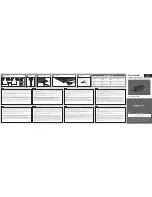
3-14
Dell Latitude CP Reference and Troubleshooting Guide
commands that start them from the start-up file. If the
problem you were experiencing does not recur, one of the
TSR programs probably created the conflict. Add the TSR
commands back into the start-up files one at a time until
you identify which TSR program is creating the conflict.
Program Conflicts
Some programs may leave portions of their setup infor-
mation behind, even though you have exited from them.
As a result, other programs cannot run. Rebooting your
computer can confirm whether or not these programs are
the cause of the problem.
Other programs use specialized subroutines called device
drivers that can cause problems in your computer. For exam-
ple, a variation in the way the data is sent to an external
monitor may require a special screen driver program that
expects a certain kind of video mode or monitor. In such cases,
you may have to develop an alternative method of running that
particular program—the creation of a boot file made especially
for that program, for example. For help with this situation, call
the support service offered by the manufacturer of the software
you are using.
Avoiding Interrupt Assignment Conflicts
Problems can arise if two devices attempt to use the same
interrupt request (IRQ) line. To avoid this type of con-
flict, check the documentation for the default IRQ line
setting for each installed device. Then consult Table 3-4
to configure the device for one of the available IRQ lines.
NOTES: Installed devices cannot share the same COM
port address. The default address of your computer’s
serial port is COM1.
To view IRQ line assignments in the Windows 95 operat-
ing system, select the Start button, and point to Settings
and then to Control Panel. Double-click the System icon.
Select the Device Manager tab, and then double-click
Computer.
Table 3-4. IRQ Line Assignments
IRQ Line
Reserved/Available
IRQ0
Reserved; generated by the system timer
IRQ1
Reserved; generated by the keyboard con-
troller to signal that the keyboard output
buffer is full
IRQ2
Reserved; generated internally by the
interrupt controller to enable IRQ8
through IRQ15
IRQ3
Available for use by a PC Card unless the
built-in serial port or infrared port is con-
figured for COM2 or COM4
IRQ4
Available for use by a PC Card unless the
built-in serial port or infrared port is con-
figured for COM1 (the default) or COM3
IRQ5
Generated by the audio controller
IRQ6
Generated by the diskette drive controller
to indicate that the diskette drive requires
the attention of the microprocessor
IRQ7
Available for use by a PC Card or audio
controller if the parallel port is disabled
IRQ8
Reserved; generated by the system I/O
controller’s RTC
IRQ9
Reserved; generated by the video controller
IRQ10
Available for use by a PC Card or audio
controller unless the C/Port Advanced Port
Replicator (APR) or C/Dock Expansion
Station is attached
IRQ11
Generated by the USB and PC Card con-
trollers; available for use by a PC Card
IRQ12
Reserved; generated by the keyboard con-
troller to indicate that the output buffer of
the touch pad or external PS/2 mouse is full
IRQ13
Reserved; generated by the math copro-
cessor
NOTE: For the full name of an abbreviation or acronym used in
this table, see the Glossary in the online System User’s Guide.
Summary of Contents for Latitude CP
Page 1: ... ZZZ GHOO FRP HOO DWLWXGH 3 5 5 1 1 7528 6 227 1 8 ...
Page 6: ...viii ...
Page 10: ...xii ...
Page 20: ...xxii ...
Page 64: ...3 28 Dell Latitude CP Reference and Troubleshooting Guide ...
Page 120: ...B 6 Dell Latitude CP Reference and Troubleshooting Guide ...
















































